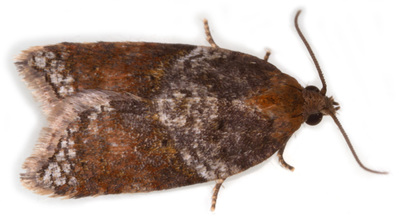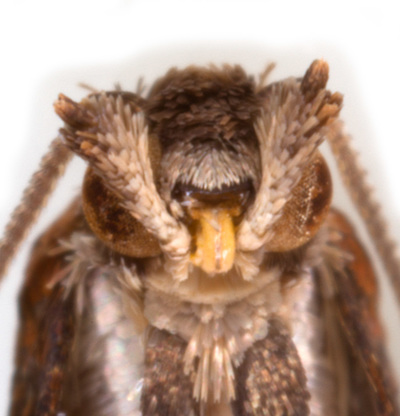49.065 Acleris comariana (Strawberry Tortrix)
ws: 13-18mm; bivoltine Jun-Jul, Aug-Oct; wild strawberry (Fragaria vesca), garden strawberry (Fragaria x ananassa), marsh cinquefoil (Comarum palustre); locally common in lowland GB
Synonym: Argrotoxa comariana (Pierce and Metcalfe)
Synonym: Argrotoxa comariana (Pierce and Metcalfe)
ID: Polymorphic and variable. Very similar to A.laterana which is larger (ws 15-20mm vs 13-18mm; fw 7-9.5mm vs 6-8.5mm). A.laterana is univoltine, flying Aug-Oct. So specimens obtained in June and July should be A.comariana; specimens obtained in Aug to Oct with fw>8.5mm should be A.laterana and with fw<7mm should be A.comariana, at fw lengths 7.0-8.5mm genital dissection is required.
Form: potentillana - costal blotch blackish, ground colour beige, sub-basal fascia obsolescent. Similar to A.laterana f. comparana
Form: comparana - costal blotch blackish, ground colour yellow-brown
Form: fasciana - costal blotch blackish, ground colour whitish-grey coarsely irrorate fuscous and suffused red-brown between costal blotch and dorsum
Form: latifasciana - costal blotch red-brown, otherwise as f. fasciana. Similar to A.laterana f. laterana
Form: proteana - costal blotch red-brown, ground colour light grey. Similar to A.laterana f. labeculana
Form: brunneana - costal blotch red-brown, ground colour red-brown, sub-basal fascia obsolescent
Form: fuscana - costal blotch poorly defined
Male genitalia: The aedeagus of A.laterana has 2 long and several smaller cornuti; that of A.comariana contains no cornuti. Moth Dissection also mentions that the ventral incision of the sacculus is deeper in A.laterana than in A.comariana, but this is a much less convincing distinguishing feature than that provided by the aedeagus.
Female genitalia: Features differentiating A.comariana from A.laterana are as follows, features of A.comariana are given first:
1. Anterior border of sterigma "W"-shaped with central hump and short lateral points vs "U"-shaped with no central hump and long lateral points;
2. Triangular sclerotisation in antrum absent vs present;
3. Signum present vs absent? The signum of A.comariana is described by Pierce and Metcalfe as a "small scobinate scar" and this is also illustrated in MBGBI5.1 p219 fig.8 and implied by its labelled absence in an image of A.laterana at Moth Dissection - however it is not really apparent in any of the images of the female genitalia of A.comariana at Moth Dissection - so I conclude that features 1. & 2. are more obvious.
Form: potentillana - costal blotch blackish, ground colour beige, sub-basal fascia obsolescent. Similar to A.laterana f. comparana
Form: comparana - costal blotch blackish, ground colour yellow-brown
Form: fasciana - costal blotch blackish, ground colour whitish-grey coarsely irrorate fuscous and suffused red-brown between costal blotch and dorsum
Form: latifasciana - costal blotch red-brown, otherwise as f. fasciana. Similar to A.laterana f. laterana
Form: proteana - costal blotch red-brown, ground colour light grey. Similar to A.laterana f. labeculana
Form: brunneana - costal blotch red-brown, ground colour red-brown, sub-basal fascia obsolescent
Form: fuscana - costal blotch poorly defined
Male genitalia: The aedeagus of A.laterana has 2 long and several smaller cornuti; that of A.comariana contains no cornuti. Moth Dissection also mentions that the ventral incision of the sacculus is deeper in A.laterana than in A.comariana, but this is a much less convincing distinguishing feature than that provided by the aedeagus.
Female genitalia: Features differentiating A.comariana from A.laterana are as follows, features of A.comariana are given first:
1. Anterior border of sterigma "W"-shaped with central hump and short lateral points vs "U"-shaped with no central hump and long lateral points;
2. Triangular sclerotisation in antrum absent vs present;
3. Signum present vs absent? The signum of A.comariana is described by Pierce and Metcalfe as a "small scobinate scar" and this is also illustrated in MBGBI5.1 p219 fig.8 and implied by its labelled absence in an image of A.laterana at Moth Dissection - however it is not really apparent in any of the images of the female genitalia of A.comariana at Moth Dissection - so I conclude that features 1. & 2. are more obvious.
§1 Foulness, Essex; 26/06/2007; fw 6.5mm; form proteana
§2 Pegwell Bay, Kent; 28/09/2009; male; fw 8.0mm; form fasciana?
§3 Foulness, Essex; 04/07/2010; male; fw 7.0mm; form latifasciana
§4 Foulness, Essex; 20/07/2013; male; fw 7.0mm; form latifasciana
§5 Removed
§6 Removed
§7 Foulness, Essex; 27/06/2015; male; form latifasciana; fw 7.5mm
§8 Glen Affric, Inverness-shire; 30/07/2023; male; fw 6.9mm
All images © Chris Lewis
§2 Pegwell Bay, Kent; 28/09/2009; male; fw 8.0mm; form fasciana?
§3 Foulness, Essex; 04/07/2010; male; fw 7.0mm; form latifasciana
§4 Foulness, Essex; 20/07/2013; male; fw 7.0mm; form latifasciana
§5 Removed
§6 Removed
§7 Foulness, Essex; 27/06/2015; male; form latifasciana; fw 7.5mm
§8 Glen Affric, Inverness-shire; 30/07/2023; male; fw 6.9mm
All images © Chris Lewis
Page published 14/10/2012 (§1-3) | §4 added 09/11/2013 | §5 added 24/12/2013 | §6 added 19/12/2014 | §7 added 08/02/2016 |
§5&6 removed 12/12/2016 - reidentified as A.caledoniana | Female genitalia text amended 03/11/2019 | §8 added 10/12/2023
§5&6 removed 12/12/2016 - reidentified as A.caledoniana | Female genitalia text amended 03/11/2019 | §8 added 10/12/2023














